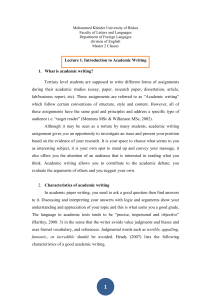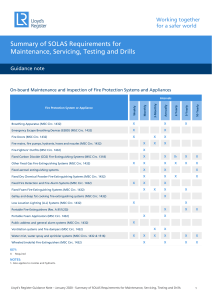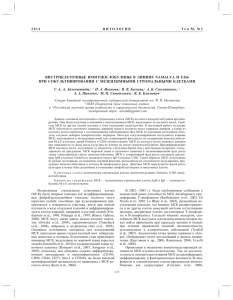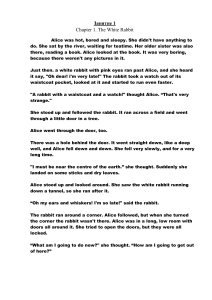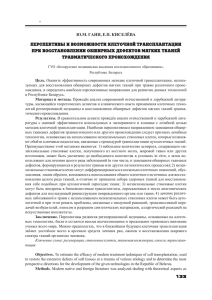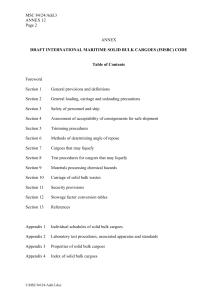от повреждающей дозы облучения (адаптивный ответ), причем
реклама
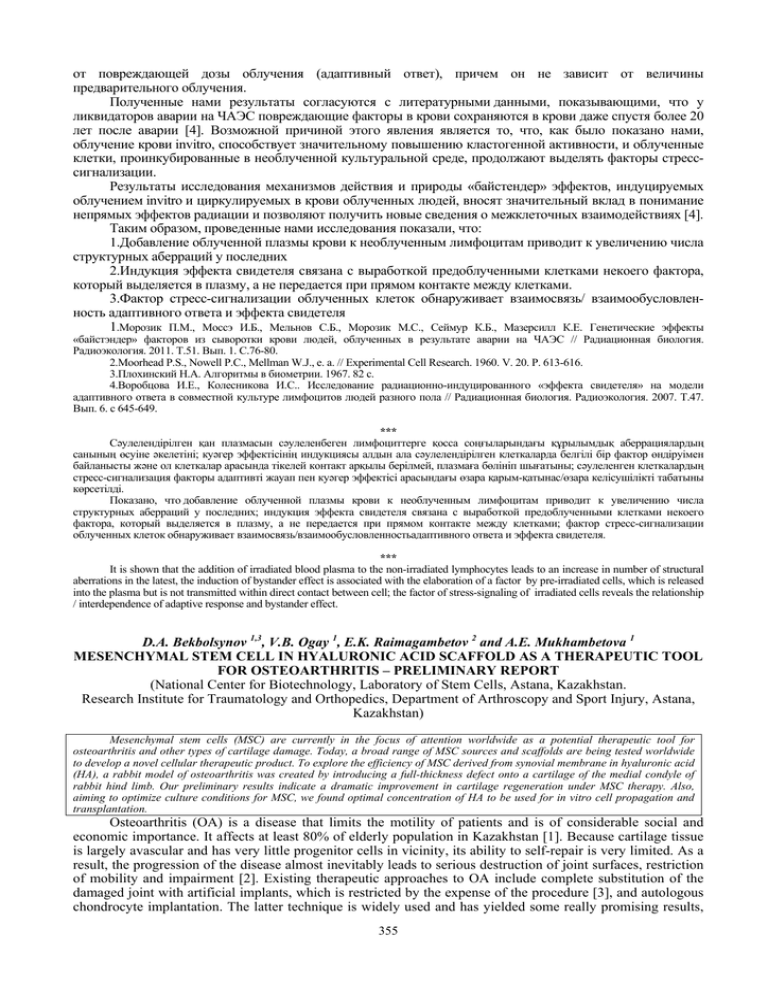
от повреждающей дозы облучения (адаптивный ответ), причем он не зависит от величины предварительного облучения. Полученные нами результаты согласуются с литературными данными, показывающими, что у ликвидаторов аварии на ЧАЭС повреждающие факторы в крови сохраняются в крови даже спустя более 20 лет после аварии [4]. Возможной причиной этого явления является то, что, как было показано нами, облучение крови invitro, способствует значительному повышению кластогенной активности, и облученные клетки, проинкубированные в необлученной культуральной среде, продолжают выделять факторы стресссигнализации. Результаты исследования механизмов действия и природы «байстендер» эффектов, индуцируемых облучением invitro и циркулируемых в крови облученных людей, вносят значительный вклад в понимание непрямых эффектов радиации и позволяют получить новые сведения о межклеточных взаимодействиях [4]. Таким образом, проведенные нами исследования показали, что: 1.Добавление облученной плазмы крови к необлученным лимфоцитам приводит к увеличению числа структурных аберраций у последних 2.Индукция эффекта свидетеля связана с выработкой предоблученными клетками некоего фактора, который выделяется в плазму, а не передается при прямом контакте между клетками. 3.Фактор стресс-сигнализации облученных клеток обнаруживает взаимосвязь/ взаимообусловленность адаптивного ответа и эффекта свидетеля 1.Морозик П.М., Моссэ И.Б., Мельнов С.Б., Морозик М.С., Сеймур К.Б., Мазерсилл К.Е. Генетические эффекты «байстэндер» факторов из сыворотки крови людей, облученных в результате аварии на ЧАЭС // Радиационная биология. Радиоэкология. 2011. Т.51. Вып. 1. C.76-80. 2.Moorhead P.S., Nowell P.C., Mellman W.J., е. а. // Experimental Cell Research. 1960. V. 20. P. 613-616. 3.Плохинский Н.A. Алгоритмы в биометрии. 1967. 82 с. 4.Воробцова И.Е., Колесникова И.С.. Исследование радиационно-индуцированного «эффекта свидетеля» на модели адаптивного ответа в совместной культуре лимфоцитов людей разного пола // Радиационная биология. Радиоэкология. 2007. Т.47. Вып. 6. с 645-649. *** Сəулелендірілген қан плазмасын сəулеленбеген лимфоциттерге қосса соңғыларындағы құрылымдық аберрациялардың санының өсуіне əкелетіні; куəгер эффектісінің индукциясы алдын ала сəулелендірілген клеткаларда белгілі бір фактор өндіруімен байланысты жəне ол клеткалар арасында тікелей контакт арқылы берілмей, плазмаға бөлініп шығатыны; сəулеленген клеткалардың стресс-сигнализация факторы адаптивті жауап пен куəгер эффектісі арасындағы өзара қарым-қатынас/өзара келісушілікті табатыны көрсетілді. Показано, что добавление облученной плазмы крови к необлученным лимфоцитам приводит к увеличению числа структурных аберраций у последних; индукция эффекта свидетеля связана с выработкой предоблученными клетками некоего фактора, который выделяется в плазму, а не передается при прямом контакте между клетками; фактор стресс-сигнализации облученных клеток обнаруживает взаимосвязь/взаимообусловленностьадаптивного ответа и эффекта свидетеля. *** It is shown that the addition of irradiated blood plasma to the non-irradiated lymphocytes leads to an increase in number of structural aberrations in the latest, the induction of bystander effect is associated with the elaboration of a factor by pre-irradiated cells, which is released into the plasma but is not transmitted within direct contact between cell; the factor of stress-signaling of irradiated cells reveals the relationship / interdependence of adaptive response and bystander effect. D.A. Bekbolsynov 1,3, V.B. Ogay 1, E.K. Raimagambetov 2 and A.E. Mukhambetova 1 MESENCHYMAL STEM CELL IN HYALURONIC ACID SCAFFOLD AS A THERAPEUTIC TOOL FOR OSTEOARTHRITIS – PRELIMINARY REPORT (National Center for Biotechnology, Laboratory of Stem Cells, Astana, Kazakhstan. Research Institute for Traumatology and Orthopedics, Department of Arthroscopy and Sport Injury, Astana, Kazakhstan) Mesenchymal stem cells (MSC) are currently in the focus of attention worldwide as a potential therapeutic tool for osteoarthritis and other types of cartilage damage. Today, a broad range of MSC sources and scaffolds are being tested worldwide to develop a novel cellular therapeutic product. To explore the efficiency of MSC derived from synovial membrane in hyaluronic acid (HA), a rabbit model of osteoarthritis was created by introducing a full-thickness defect onto a cartilage of the medial condyle of rabbit hind limb. Our preliminary results indicate a dramatic improvement in cartilage regeneration under MSC therapy. Also, aiming to optimize culture conditions for MSC, we found optimal concentration of HA to be used for in vitro cell propagation and transplantation. Osteoarthritis (OA) is a disease that limits the motility of patients and is of considerable social and economic importance. It affects at least 80% of elderly population in Kazakhstan [1]. Because cartilage tissue is largely avascular and has very little progenitor cells in vicinity, its ability to self-repair is very limited. As a result, the progression of the disease almost inevitably leads to serious destruction of joint surfaces, restriction of mobility and impairment [2]. Existing therapeutic approaches to OA include complete substitution of the damaged joint with artificial implants, which is restricted by the expense of the procedure [3], and autologous chondrocyte implantation. The latter technique is widely used and has yielded some really promising results, 355 however, the need to harvest chondrocytes from healthy tissue sites imposes unnecessary trauma and leads to prolonged regeneration periods [4]. Mesenchymal stem cells (sometimes called mesenchymal stromal stem cells) present interest from the regenerative medicine point of view due to their ability to differentiate into adipocytes, osteoblasts and chondrocytes combined with the potent impact on immune effector cells maturation and proliferation [5]. For the treatment of OA, MSC are a promising tool thanks to their chondrogenic potential, relative ease of isolation and propagation, and ability to expand in vitro without loosing their multipotency [6]. These characteristics have encouraged a range of preclinical studies in vitro [7] and in vivo [8], [9]. The majority of these studies use MSC derived from bone marrow [10], [11] as the most well studied and easily isolated cells with broad differentiation capabilities, however, the procedure of harvesting MSC from bone marrow is quite traumatic. In our research, we chose to use hyaluronic acid (HA) as a scaffold, as this is a naturally occurring component of synovial fluid that provides viscosity, lubrication. to joints and is also capable of delaying unwanted dissemination of newly transplanted cells away from the damaged site. We in the process found a positive effect of HA on MSC proliferation, which is an additional advantage of this scaffold in the future cellular therapy of OA. At first, we tested the effect of autologous MSC in HA scaffold for treatment of cartilage defects in a rabbit model of OA. This was the first stage of the research. Having obtained encouraging results, we continued our research to investigate the proliferative properties of human MSC on the second stage of the research. Materials and methods Isolation of MSC and Creation of OA Model Five skeletally mature female rabbits 10 to 12 weeks old were used in this study. Samples of synovial membrane were aseptically harvested from knee joints of rabbits during the procedure of introducing cartilage defects. Tissue samples were washed with PBS containing penicillin at 500 U/ml, streptomycin at 500 µg/ml, ampicillin, gentamycin, amphotericin B, ceftriaxone, cut into fine pieces (1-3 mm) with sterile scalpels and scissors, and then placed into the 0.4% (wt/vol) collagenase type II in complete growth medium (DMEM, 10% FBS, gentamycin) solution. After overnight incubation in CO2 incubator at 370C, the solution was filtered through 70 µm cell strainer, centrifuged at 200 g for 10 min, resuspended in 1 ml of growth medium, and viable cells were counted using trypan blue staining. This protocol was also followed during isolation of human synovial MSCs. The cells were further incubated and propagated in DMEM containing 10% and antibiotics. To create cartilage defects, approximately 5x5 mm size lesion was scraped with scalpel on a medial condyle of both hind limbs in rabbits. Cell Characterization The ability of isolated MSC to form colonies was measured using CFU assay. Briefly, a cell suspension was prepared at density of 10 cells per milliliter. 100 cells were plated onto 100 mm Petri dishes and incubated in CO2 incubator at 370C for 14 days. On day 15, the medium was removed from Petri dishes and formed colonies stained with crystal violet. To assess the proliferation rate of MSC in different concentrations of hyaluronic acid, MTT test was performed. A commercially available preparation of 1% hyaluronic acid (Ostenil®) was diluted with growth medium at 1:1, 1:2, 1:4 and 1:8 ratios, which corresponds to concentrations of hyaluronic acid of 0.5%, 0.25%, 0.12% and 0.06% respectively. Dilutions were plated on wells of 96 well plate and incubated for 48 hours. After incubation, MTT reagent was added and staining performed according to standardized protocol. Differentiation Assays When the results of MSC transplantation in rabbit model of OA were obtained, we continued our research to explore the characteristics of human synovial membrane derived MSC. The samples of synovia were taken from the surgical material at the Arthroscopy and Sport Injury Department of the National Research Institute for Traumatology and Orthopedics. This material was otherwise destined to become a medical waste. The same protocol as for rabbit MSC was employed to isolate human MSC (see above). The cells were subjected to differentiation into osteogenic and chondrogenic lineages using respective StemPro® differentiation kits and manufacture’s protocols (Gibco). The cells were incubated for three weeks and then stained with alizarine red (osteogenic lineage) and toluidine blue (chondrogenic lineage). The cells demonstrated sufficient ability to differentiate into both lineages. Transplantation of Cells The cells isolated from synovial membrane were propagated for 2 to 6 passages in vitro. For transplantation back to the rabbits, 500 000 cells were diluted in 0.25% of hyaluronic acid in growth medium solution. 300 µl of this preparation were injected into joints of right hind limbs of rabbits. A cell free scaffold of HA in growth medium was used as sham control and injected into the left knee. The first transplantation was performed two weeks post induction of OA, and the second transplantation followed two weeks later. The 356 rabbits were sacrificed after two weeks post the second cell transplantation and the difference in the rate of regeneration of damaged cartilage was observed. Results Regeneration Assessment Morphological observation of condyles of sacrificed rabbits revealed a noticeable difference in regeneration between joints treated with HA+MSC versus joints treated with HA only (not shown). The followup histological study confirmed this observation: there was about 3 fold difference between the sham control group representing left knees treated with Ostenil® alone as compared to experiment group representing right knees treated with Ostenil® and autologous MSC (Fig. 1). Figure 1. The results of histological study of rabbit knee joints after the course of regeneration under MSC therapy. The histology slides were prepared using conventional technique and stained with eosin (above) and hematoxylin (below). Pictures a and c are sham controls treated with the hyaluronic acid scaffold alone. Pictures b and d are experiment group treated with autologous MSC in HA scaffold. The presence of cells in the outer layer of these sections indicated the formation of neocartilage in the place of the former defect. There is a noticeable difference in the thickness of neocartilage layer between controls and experiments. These layers are indicated with two side arrows in pictures c and d. Colony Forming and Cell Proliferation The CFU assay with rabbit MSC has shown a significant colony forming ability of the cells (over 50%). To measure proliferation rate of rabbit MSC at different concentrations of HA, MTT proliferation assay was performed using conventional technique. The absorbance was read at the wavelength of 595 nm. MSC demonstrated the highest proliferation at the concentration of HA equal to 0.25%. Interestingly, SM-MSCs at 0.25% HA also displayed altered morphology and appeared more spindle shaped and fibroblast-like compared with controls. We also report improved MSC proliferation in growth medium supplemented with the combination of TGF-β1, BMP-2 and bFGF-2, but not with BMP-2 alone (Fig.2). These results were also obtained by running MTT test on 96 well plate with 6 repeats. Figure 2. MSC proliferation was measured using MTT test at different concentrations of hyaluronic acid (A) and different growth factors (B). All growth factors were used at concentrations of 10 ng/ml, and cells incubated in regular growth medium were used as control. These results indicate that Ostenil® as a hyaluronic 357 acid product is a valid scaffold for autologous MSC propagation and transplantation. Also, TGF-β1 and BMP-2 appear to inhibit proliferation of MSC, as opposed to bFGF-2 and the combination of three. Discussion OA is a degenerative disease that affects vast numbers of people both in Kazakhstan and worldwide. Even though there is no disease-modifying treatment of OA today, pre-clinical studies on animal models of OA yield promising results and allow us to hope for the development of novel MSC based products in near future. Hyaluronic acid as a component of normal cartilage appears to be a promising candidate to be used as a scaffold for future MSC transplantations. The effect of HA in various forms was tested [12], [13]. We observed unambiguous increase in MSC proliferation rate when the cells were cultured in its presence. We also found statistically significant difference between MSC in HA scaffold and HA scaffold alone in their ability to induce cartilage repair in histological sections of rabbit knees. On the other side, some scientists report the absence of difference in healing under MSC+HA versus HA alone treatments [14], [15], however, these authors used bone marrow derived MSC in their study, and synovial MSC were reported to have greater chondrogenic potential compared to MSC from bone marrow [16]. We also found the beneficial effect of the combination of three growth factors on MSC culture, including of TGF-β1, BMP-2 and bFGF-2 at 10 ng/ml, where bFGF-2 appears to be the most important in imposing mitogenic effect on MSC in dose-dependent manner. These results agree with previously established ability of skew MSC phenotype from differentiation to maintenance [17]. Our preliminary results also show a slight increase in proliferation when growth factors are used in combination with 0.25% hyaluronic acid (not shown). Developing an optimal combination of growth factors for MSC propagation is important for their future use in medicine, especially for obtaining therapeutic numbers of autologous stem cells in cases, where only a limited amount of primary cells can be isolated from a patient. We further aim to investigate the properties of human synovial membrane derived mesenchymal stem cells, and eventually take the research up to the level of clinical trials. MSC are a promising therapeutic tool, and there are reasons for us to hope that stem cell based therapy will become routinely used for treatment of cartilage damage in Kaznakhstan in the near future. 1. Национальный пресс-клуб: Актуальные вопросы артрологии в Республике Казахстан и пути их решения. Астана; 2010. 2. The burden of musculoskeletal conditions at the start of the new millennium. World Health Organ Tech Rep Ser 2003, 919:i-x, 1218, back cover. 3. March LM, Cross M, Tribe KL, Lapsley HM, Courtenay BG, Cross MJ, Brooks PM, Cass C, Coolican M, Neil M, Pinczewski L, Quain S, Robertson F, Ruff S, Walter W, Zicat B: Two knees or not two knees? Patient costs and outcomes following bilateral and unilateral total knee joint replacement surgery for OA. Osteoarthritis Cartilage 2004, 12:400-408. 4. Grigolo B, Lisignoli G, Desando G, Cavallo C, Marconi E, Tschon M, Giavaresi G, Fini M, Giardino R, Facchini A: Osteoarthritis treated with mesenchymal stem cells on hyaluronan-based scaffold in rabbit. Tissue Eng Part C Methods 2009, 15:647-658. 5. Prockop DJ: Marrow stromal cells as stem cells for nonhematopoietic tissues. Science 1997, 276:71-74. 6. Csaki C, Schneider PR, Shakibaei M: Mesenchymal stem cells as a potential pool for cartilage tissue engineering. Ann Anat 2008, 190:395-412. 7. Noth U, Steinert A, Tuan R: Technology insight: adult mesenchymal stem cells for osteoarthritis therapy. Nat Clin Pract Rheumatol 2008, 4:371-380. 8. Murphy J, Fink D, Hunziker E, Barry F: Stem cell therapy in a caprine model of osteoarthritis. Arthritis Rheum 2003, 48:34643474. 9. Wakitani S, Imoto K, Yamamoto T, Saito M, Murata N, Yoneda M: Human autologous culture expanded bone marrow mesenchymal cell transplantation for repair of cartilage defects in osteoarthritic knees. Osteoarthritis Cartilage 2002, 10:199-206. 10. Kayakabe M, Tsutsumi S, Watanabe H, Kato Y, Takagishi K: Transplantation of autologous rabbit BM-derived mesenchymal stromal cells embedded in hyaluronic acid gel sponge into osteochondral defects of the knee. Cytotherapy 2006, 8:343-353. 11. Liu Y, Shu X, Prestwich G: Osteochondral defect repair with autologous bone marrow-derived mesenchymal stem cells in an injectable, in situ, cross-linked synthetic extracellular matrix. Tissue Eng 2006, 12:3405-3416. 12. Campoccia D, Doherty P, Radice M, Brun P, Abatangelo G, Williams DF: Semisynthetic resorbable materials from hyaluronan esterification. Biomaterials 1998, 19:2101-2127. 13. Solchaga L, Temenoff J, Gao J, Mikos A, Caplan A, Goldberg V: Repair of osteochondral defects with hyaluronan- and polyesterbased scaffolds. Osteoarthritis Cartilage 2005, 13:297-309. 14. Loken S, Jakobsen RB, Aroen A, Heir S, Shahdadfar A, Brinchmann JE, Engebretsen L, Reinholt FP: Bone marrow mesenchymal stem cells in a hyaluronan scaffold for treatment of an osteochondral defect in a rabbit model. Knee Surg Sports Traumatol Arthrosc 2008, 16:896-903. 15. Baier L, Bivens K, Patrick C, Schmidt C: Photocrosslinked hyaluronic acid hydrogels: natural, biodegradable tissue engineering scaffolds. Biotechnol Bioeng 2003, 82:578-589. 16. De B, Dell'Accio F, Tylzanowski P, Luyten FP: Multipotent mesenchymal stem cells from adult human synovial membrane. Arthritis Rheum 2001, 44:1928-1942. 17. Lai W, Krishnappa V, Phinney D: Fibroblast growth factor 2 (Fgf2) inhibits differentiation of mesenchymal stem cells by inducing Twist2 and Spry4, blocking extracellular regulated kinase activation, and altering Fgf receptor expression levels. Stem Cells 2011, 29:11021111. 358
